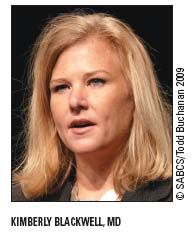Dual HER2-blockade regimen boosts overall survival in refractory metastatic breast ca
The targeted combination of lapatinib (Tykerb) plus trastuzumab (Herceptin) led to a median overall survival of 14 months in women with refractory metastatic breast cancer.
SAN ANTONIO-The targeted combination of lapatinib (Tykerb) plus trastuzumab (Herceptin) led to a median overall survival of 14 months in women with refractory metastatic breast cancer, according to an updated analysis of the phase III EGF104900 trial. SABCS 2009 presenter Kimberly Blackwell, MD, said she would favor the combination treatment in patients with HER2-driven tumors who did well on multiple lines of trastuzumab.
“There was a clinically important 4.5-month increase in overall survival [OS] with the combination of lapatinib plus trastuzumab in a population of heavily pretreated HER2-positive metastatic breast cancer [MBC] patients despite the fact that half the patients crossed over from the single agent to the combination,” said Dr. Blackwell, who is based at Duke University Medical Center in Durham, N.C. “This magnitude of effect is similar to that seen with other biologic agents plus chemotherapy in the first-line setting, but without the significant side effects associated with traditional chemotherapy.”

While both drugs target the HER2 receptor, lapatinib also targets the HER1 receptor and does not require extracellular domain binding. This combination of two mechanistically different treatment strategies form a dual HER2 blockade, which has been shown preclinically to delay the time to treatment resistance, she said.
Last year, Joyce O'Shaughnessy, MD, reported that clinical benefit rates improved from 12.4% with single-agent treatment with lapatinib to 24.7% with the combination therapy. Progression-free survival improved by about one month (P = .008), and OS improved by nearly three months, but this was not statistically significant (ASCO 2008 abstract 1015).
EGF104900 included 296 MBC patients with HER2-positive tumors who experienced disease progression after treatment with an anthracycline, a taxane, and trastuzumab. The average patient had received four or five prior regimens, and approximately one-third had received at least six prior regimens. The median time from the last trastuzumab treatment was one month (SABCS 2009 abstract 61).

Patients were randomized to oral lapatinib (1,500 mg/d) or to lapatinib (1,000 mg/d) plus trastuzumab weekly. After at least four weeks of single-agent treatment, patients could cross over to combination treatment, which 52% of the control arm did. At the data cutoff point for this current analysis, 75% of the patients had died.
In the updated intention-to-treat analysis, median OS was 14 months with lapatinib plus trastuzumab compared with 9.5 months with lapatinib alone, for a 26% reduction in risk of death (P = .026). One-year OS was 56% vs 41%, Dr. Blackwell reported.
Baseline factors shown to predict better outcomes included good performance status, nonvisceral metastatic sites, fewer than three metastatic sites, and longer time from initial diagnosis to randomization. After adjustments for these significant baseline covariates, the OS benefit was still robust, with a 29% reduction in risk (P = .016), she added.
In the updated analysis of cardiac and other safety events, 11 of 149 patients who received the combination had a grade 3 or 4 toxicity compared with three of 147 who received the single agent. Serious events were reported in 10 patients on the combination regimen and in three who took the single agent. There was one fatal pulmonary embolism in a patient in the combination arm.
“What impresses me most is that the majority of adverse events were grade 1 or 2,” Dr. Blackwell said. “The only grade 3 or 4 event with = 5% incidence was diarrhea, seen in 8% on the combination and 7% with the single agent.”
These findings further strengthen the NCCN guidelines that list this combination as preferred for trastuzumab-exposed HER2-positive disease, she said. The ongoing ALTTO trial will evaluate this combination in the adjuvant setting in a population of 8,000 patients.